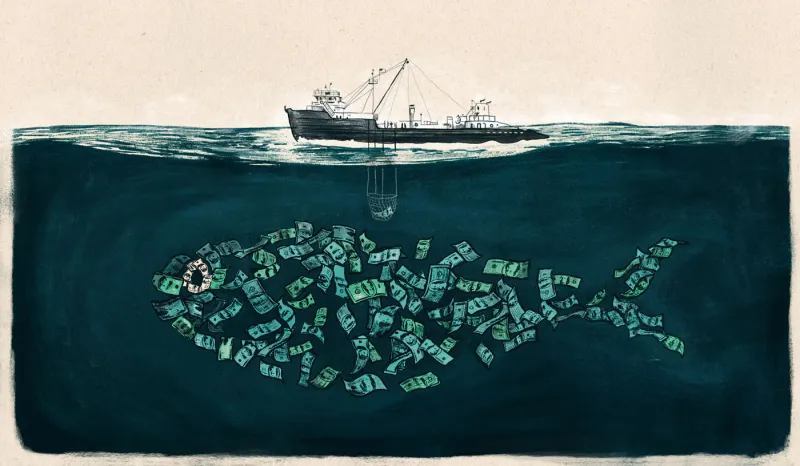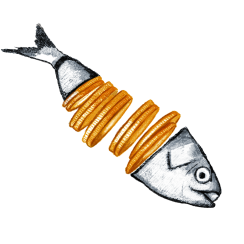
Illustrations by Peter Strain
The menhaden, for the uninformed, is a fish — one that swims at the base of the enormous, yet fragile, pyramid of sea life. At the top of that pyramid exist whales, which, after disappearing decades earlier from New York City environs, were spotted again in 2010, just a few miles from Manhattan’s famous skyline.
Which is how, on a sunny July weekday, I find myself approaching the American Princess, a whale-watching boat docked at Riis Landing on the bay side of Rockaway. The boat is here to look for whales — and so am I.
Tom Paladino, white-haired and tan, sits on the bumper of his truck in the gravel parking lot abutting the dock. He fits the image of a man who has been in the fishing business 45 years. Paladino started running whale-watching excursions on the American Princess with his partner, Frank De Santis, in 2010.
For decades it had been rare to see a whale or its primary Atlantic meal, the silvery, oily fish called menhaden. Before menhaden took over from whales as humans’ choice source of sea oil, the big marine mammals had been hunted almost to extinction. And when humans switched to menhaden and from harpoons to spotter planes and industrial fishing nets, many of the remaining whales starved. Whales eat menhaden by the thousands. If their population was rebounding, then whales, dolphins, bluefish, striped bass, and other marine life couldn’t be far behind.
“Ten years ago, heart to mouth, there were more and more reports of whales,” says Captain Paladino in a New York accent that is slowly disappearing from the city. Paladino and De Santis were cautiously optimistic and started bringing people out, one day a week at first. More than half the time, the passengers saw whales. By 2014 — two years after catch limits on menhaden cut commercial hauls by about 20 percent — Paladino says he “saw bunkers, 40 feet thick, tens of thousands.” Bunkers are one of many local names for the slimy and stinky menhaden. Now, 90 percent of the time that De Santis takes the boat out, he sees whales, sturgeon, seals, and even dolphins.
Paladino — who grew up in south Brooklyn — remembers when in the 1960s, 100-foot-plus gray ships arrived from Reedville, Virginia, with smaller aluminum boats perched on their decks. They had been sent to capture menhaden by a company now called Omega Protein. Men in the smaller aluminum boats would position massive nets — purse seines — over pods of fish located by spotter planes and zip them up. The fish would then be loaded onto the factory ships.
Omega Protein was one of many so-called menhaden reduction companies operating at the time. These companies captured menhaden in great volumes and processed them into fish meal, oil, and other commodities. It took just three days to make the fish vanish for the rest of the year, says Paladino. Until there was legislation to block foreign vessels from fishing within a certain distance of the U.S. coast, he would also see Russian trawlers enter the bay in 30-boat fleets.
Paladino’s memories of bunker decimation and depleted populations in the ’60s fits with the view of Hall Watters, the first spotter pilot in the menhaden industry. According to Bruce Franklin’s book The Most Important Fish in the Sea, Watters saw 1960 as the turning point.
That year technology — from better netting to fish pumps — enabled boats to surround and capture massive schools and suck them from the sea. Watters, who died in 2004, recounted the destruction of a school he estimated to be about five city blocks in diameter and 125 feet tall. After that the fish pods started shrinking and the population began plummeting, writes Franklin. By 1967 fisheries were catching nothing significant in the North Atlantic, according to the book.
In the late 1990s and early 2000s, Maine, New Jersey, New York, and other Atlantic coast states began curtailing what remained of the menhaden industry. (Omega Protein and others can still catch Gulf menhaden — smaller and less desirable than their Atlantic brethren.) The prohibitions came as sports fishermen and environmentalists called attention to the declining populations of species like bluefish, which were reliant on the shrinking menhaden populations.
But the state restrictions required little sacrifice. Most of the reduction industry, which dates back to the 1860s, overfished menhaden and put themselves out of business.
Omega Protein, a precursor of which owned the boats Paladino vividly remembers, now runs the last reduction factory on the East Coast. It’s based in Reedville, Virginia, in the only Atlantic state that still allows the industry to operate. Omega takes 80 percent of the menhaden catch on the East Coast (about 130,000 metric tons a year, down from 160,000 the year before the 2012 limits were put in place), and the bait industry takes the rest.
“A 45-foot tractor trailer holds 20 tons. That’s a lot of tractor trailers,” says Jim Rogers, a former Chesapeake Bay Foundation board member.
For decades Omega has been at the center of controversy over its role in depleting menhaden populations on the East Coast and in the Chesapeake Bay; the size of a healthy population of menhaden; and even the role the fish plays in the ecosystem.
Bob Vanasse — head of commercial fisheries advocacy group Saving Seafood — disputes the notion that menhaden are even threatened. He points to their robust fertility, and notes that the debate goes back more than a century. According to Vanasse, the new head of the National Marine Fisheries looked at official data as recently as November and said the current quota could be doubled without hurting the menhaden population.
Vanasse acknowledges that recreational fishermen are irritated when they see boats use purse seines and spotter planes to pull menhaden schools from the water. Hobbyists also seek out the oily schools, which attract what they are after: striped bass and other sporting species. “The purse seine goes out there and takes the whole school,” Vanasse says. But, he argues, “it’s efficient, and there’s no by-catch” — collateral damage to other marine life.
Paul Eidman, a fourth-generation fisherman aboard the American Princess, is not convinced. “The reality is that Omega Protein makes nothing that can’t be replaced,” says Eidman, who represents the mid-Atlantic for a group called Menhaden Defenders. Some of Omega Protein’s products, such as an ingredient for dog food, could be easily replaced by other commodities. Technology companies are researching the development of substitutes for fish meal, another Omega Protein product, used as a feed for aquaculture. With the state’s protection, capitalism isn’t working the way it should. “There are much more attractive industries that can replace all of this,” he says.

In 1973 oil company Zapata (founded by George H.W. Bush, who had left by then) bought what was then called Haynie Products and subsequently sold it to real estate titan Malcolm Glazer, who renamed it Omega Protein in the early 1990s. By 1997 the Glazers had acquired all but two of its competitors and took the company public.
In late 2016, while it was a listed firm, a Louisiana U.S. District Court found Omega had violated the Clean Water Act by discharging pollutants and harmful amounts of oil from its fishing boats. This was its second run-in with state justice officials in a handful of years. In June 2013, Omega Protein entered into a plea agreement with the Eastern District of Virginia to resolve a government investigation into the fishing vessels and operations of its Reedville facility. Omega Protein pleaded guilty to two felony counts under the Clean Water Act; paid a fine of $5.5 million; made a $2 million contribution to an environmental fund; and was sentenced to a three-year probation term that was originally scheduled to end in June 2016, but which was extended for two years owing to violations at the company’s Louisiana facilities.
Omega Protein has been cited for 25 violations of Occupational Safety and Health Administration rules. Ben Landry, director of public affairs for the company, says “it paid the price” for violating the Clean Water Act and OSHA rules. It has since terminated people involved and changed personnel, bringing in more staff with environmental backgrounds, Landry adds.
Because Omega was a public company, its largest shareholders were passive investors that by design do not exert pressure on businesses for changes. These shareholders own everything — good and bad — in their investable universe.
Virginia politicians, unions, and the NAACP have also protected Omega Protein. Although Omega has had a succession of owners and is headquartered in Houston, its processing plant for Atlantic menhaden remains in Reedville. Reedville takes its name from the man behind one of the first reduction factories.
Virginia is the only East Coast state that maintains a reduction fishery for menhaden. Landry points out that the company is the largest employer in Northumberland County and a large employer of minorities. Many of the people who work there would have few other opportunities, he says, except in tourism.
The only control on Virginia waters is the Atlantic States Marine Fisheries Commission. The organization set a cap — 51,000 metric tons — on the amount of menhaden that could be taken from the Chesapeake. “And Omega is thumbing its nose at the rule,” asserts David Sikorski, executive director of the Coastal Conservation Association Maryland. The ASMFC is set to rule at its next annual meeting on whether or not Omega Protein is complying with the cap.
In 2017 violations caught up with the company, whose stock fell 20 percent after it revealed a Securities and Exchange Commission subpoena for information on a subsidiary’s compliance with probation terms and protections for whistle-blowers.
Andre Shepley, a researcher at TruValue Labs — whose independent reports flag environmental, social, and governance factors with material impact on companies’ value — says investors who paid attention to ESG could have saved themselves from the dive in Omega Protein’s stock.
A report TruValue produced for Institutional Investor shows Omega Protein’s ESG score — a proprietary rating of risk factors — dropping in 2012 and 2013 thanks to what it calls environmental and operational negligence. “Ultimately, ESG underperformance vs. its sector led to a 20 percent decline in its stock,” Shepley writes in the report.
“Way back in 2011 there were a series of different things that showed how negligent their practices were,” he says. Still, the company’s largest investors — BlackRock and Dimensional Fund Advisors — were passive shareholders that didn’t do anything about it. “A large point here is there were no shareholders engaging in conversations with management,” Shepley notes.
All of the big passive players have paid a lot more attention to governance in recent years, after being criticized for not voting their shares even as their stakes in companies grew. But critics say they rarely dig into the issues faced by individual companies, particularly the small ones, relying instead on third-party advisers for guidance on voting. The low fees index funds charge don’t cover extensive research, and the funds aren’t making active decisions about their holdings. If they did, they’d be called active managers.
That’s changing. Index funds are increasingly doing independent research to determine how to vote and to uncover the major issues facing a firm or sector, and they’re holding meetings with a growing number of companies. BlackRock, Omega Protein’s largest investor when it was public, is doubling the size of its corporate governance team over the next few years. It takes what it calls an engagement-first approach and sees proxy voting as just one part of its process. State Street Global Advisors has also ratcheted up its work on governance, including a high-profile push for more diversity on boards.
BlackRock engages with companies behind the scenes on issues that it believes affect their value long-term, whether it’s macroeconomic trends or societal issues like climate change. A company with production facilities that could be affected by rising sea levels as the climate warms needs to mitigate that risk. BlackRock doesn’t make recommendations to companies, but it asks questions about how management is accounting for litigation risks, what steps it is taking to support the responsible use of its product, or how it plans to improve its safety record. A spokesman says BlackRock gives companies time to make changes and then, if little progress is made, will express its view through its vote. It can’t sell its holdings, but BlackRock believes it has even more influence because it’s the ultimate long-term shareholder.
The spokesman says BlackRock won’t comment publicly on any of its conversations with companies. According to proxy advisor ISS, in 2017 BlackRock always voted with the management of Omega Protein, except on “say on pay.”
After the February mass shooting at Marjory Stoneman Douglas High School, BlackRock CEO Larry Fink addressed the issue of index funds investing in gun manufacturers. Many thought Fink — who said BlackRock would hold discussions with gun manufacturers — was highlighting the meetings to make a point about the moral and ethical arguments of investing in these companies. But Fink was being pragmatic. The business of gun manufacturing or retailers selling weapons — whatever an investor’s personal view — may not be viable if these companies fail to address safety and weapons access. Index funds could then make the case to use their shareholder votes to press for change. A spokesman for Dimensional declined to comment.
But there were also active managers who owned Omega Protein. One activist manager says it looks at environmental or social issues only if they will affect the long-term value of a company it owns. It determined after researching the issues at Omega Protein, however, that it was doing nothing wrong. The manager did believe the company wasted money on an expansion into the human-nutrition business and missed an opportunity to benefit from a change in regulations.
Although the activist firm wasn’t an obvious ally of environmentalists and other advocacy groups, it pushed for changes to the board that benefited all shareholders. The manager launched a proxy contest against what it felt was an entrenched board that didn’t have the skills to execute a strategic plan for Omega Protein. Twice the company unilaterally passed measures to limit shareholders’ rights.
During the proxy contest the manager needed votes on its side and reached out to the major index funds as the stock was dropping. But the index funds can’t be stereotyped when it comes to how they deal with governance and other shareholders in the companies they own, says one official at the activist firm. One large passive manager, for example, meets face-to-face with firms; some generally vote with management; and others put a lot of weight on recommendations from proxy advisers like ISS.
As index funds gain larger stakes in companies, activists have fewer natural allies. “In the past we would be able to go to management before a fight and tell them we had 40 percent of the votes in our back pocket,” says the official. But that 40 percent was made up of active managers, whose market share is dropping. “There are basic things that companies can get away with when they have lots of index holders.” Landry declined to comment on the activist fight.
And that force is growing. Assets are flowing from active into traditional market-cap-weighted index funds, but also into newer smart beta and factor-based products. Algorithms programmed to find certain characteristics pick securities to invest in, and the strategies arguably are actively managed. But it’s doubtful computer-run funds will be active in corporate governance.
Proxy advisers such as ISS and Glass Lewis have been criticized for a lack of transparency given the quiet power they wield in corporate America. But many say the companies have been upping their game and are producing more-thorough reports, which in turn sway thousands of major shareholders who vote based on their recommendations.
For now, it’s still the advocacy groups, not investors, that are most likely to push for change.
Bill Michaelcheck is both. Chief investment officer and founder of Mariner Investment Group and an avid fly fisherman, Michaelcheck helped form a group of financial executives to tackle issues surrounding menhaden.
“The power of this small company is amazing. It has a tremendous influence over the marine ecology of the entire East Coast,” says Michaelcheck. “It is hard to believe that the former institutional shareholders of Omega Protein approved of the company’s actions.”
To sports fishermen like Michaelcheck, menhaden’s recent resurgence demonstrates that small restrictions can help fish populations recover quickly. To commercial fishermen the recovering stock means that catch limits should be raised now that there are more fish in the sea.
That is just what the powerful Atlantic States Marine Fisheries Commission is doing: allowing the commercial catch to slowly rise to historic levels.
“The less Omega Protein catches the better. To go up now is crazy,” says Tom Paladino, the Brooklynite who saw fisheries empty local waters in the 1960s and now takes day trippers there to see whales. “After they put the restrictions in in 2012, [Omega Protein] lived. They made a living. Everything is going good. Why change it? It’s crazy. When you devastate a species, it takes a long time to come back, if it ever does.”
“What are humpback whales doing in New York City?” says marine educator Catherine Granton of Gotham Whale as the American Princess heads west toward the Atlantic Ocean. “They’re hungry. They’re coming for menhaden, bunker, a silvery fish 12 inches in length, dense and rich in DHA and AHA. Humpbacks consume thousands per day and take on all the blubber and fat they burned over the winter season. They spend the winter months in the warmer waters of the Caribbean. While they’re there, it’s all about reproduction, not eating,” she explains.
“Look over the starboard side; you’ll see Brooklyn. Here we are in the shadows of Manhattan— Gotham City — and we’re going to observe humpback whales in their native habitat. It’s the return of that forage fish that is bringing the whales into our area,” she says.
The captain’s voice cuts in over the speaker.
“There she blows!”





